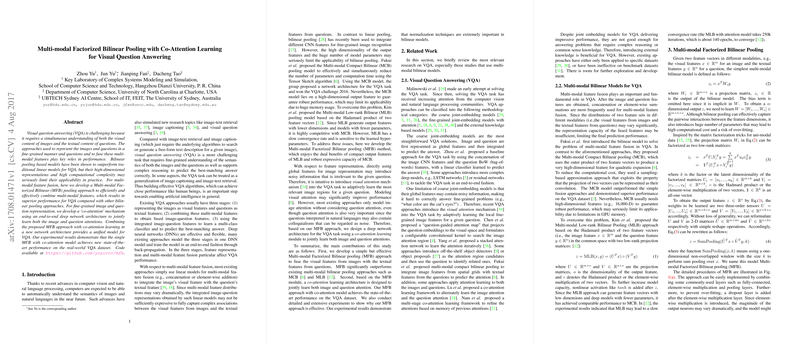Multi-modal Factorized Bilinear Pooling with Co-Attention Learning for Visual Question Answering
The paper "Multi-modal Factorized Bilinear Pooling with Co-Attention Learning for Visual Question Answering" addresses the complex task of Visual Question Answering (VQA). It presents an innovative approach for multi-modal feature fusion using Multi-modal Factorized Bilinear (MFB) pooling combined with a co-attention learning mechanism. This approach is shown to enhance the performance of VQA models significantly.
Overview
Visual Question Answering (VQA) involves answering questions about images, requiring the model to process both visual and textual information. Traditional linear models have struggled to capture the intricate interactions between image features and question features in a compact and efficient manner. To address these shortcomings, bilinear pooling models like Multi-modal Compact Bilinear (MCB) and Multi-modal Low-rank Bilinear (MLB) have been proposed. However, these models face challenges related to computational complexity and convergence rates.
The authors propose a Multi-modal Factorized Bilinear (MFB) pooling method that capitalizes on the compactness of MLB and the robustness of MCB, providing a more efficient and expressive form of feature fusion. MFB achieves this by reducing the dimensionality of the fusion process without sacrificing performance.
Methodology
The proposed MFB approach involves factorizing the bilinear pooling into two low-rank matrices, effectively reducing the dimensionality and computational cost of feature fusion. This is achieved by implementing compact feature representation through factorization, followed by power and normalization techniques to stabilize the training process.
A complementary aspect of the paper is the introduction of a co-attention mechanism that enables the model to learn fine-grained attention over both image regions and question words simultaneously. This dual attention mechanism ensures that the model focuses on relevant visual and textual components, thereby enhancing prediction accuracy.
Experimental Results
The paper reports that the MFB model outperforms existing bilinear models, including MCB and MLB, with reduced memory usage and lower model complexity. Specifically, the MFB model achieves superior accuracy on the VQA dataset compared to MCB, with only a fraction of the parameters. Furthermore, introducing the co-attention mechanism further enhances performance, demonstrating state-of-the-art results on public datasets.
Implications and Future Work
This research has several implications for the development of VQA systems and, more broadly, for multi-modal learning tasks. By optimizing feature fusion and attention mechanisms, the paper contributes to more efficient and effective AI models capable of deeper image-text understanding and reasoning.
Future directions for this research could involve extending the co-attention mechanism to incorporate external knowledge bases to improve reasoning capabilities. Additionally, exploring the application of MFB and co-attention models in other domains, such as video question answering or robotic vision systems, may further validate and expand upon the findings presented in this paper.
In conclusion, the paper introduces a novel and effective approach for VQA by leveraging factorized bilinear pooling and co-attention learning, setting a new benchmark in the field and opening avenues for subsequent research and applications in AI.
